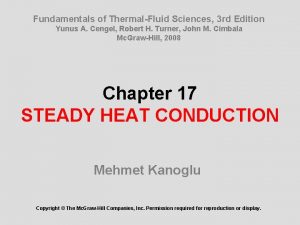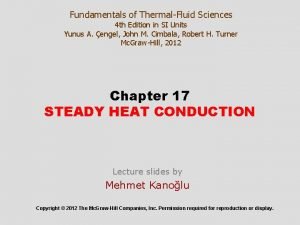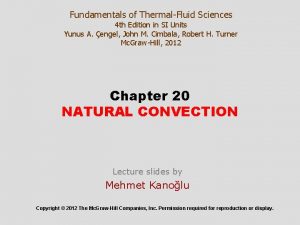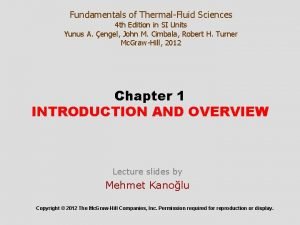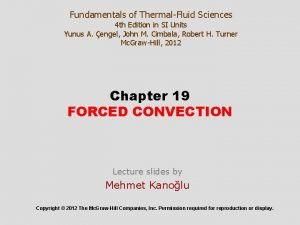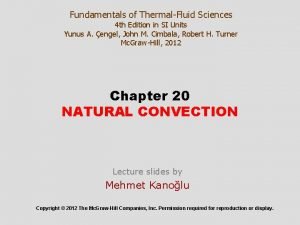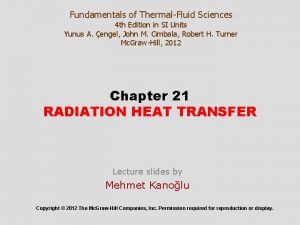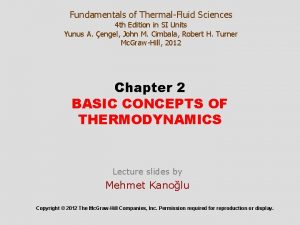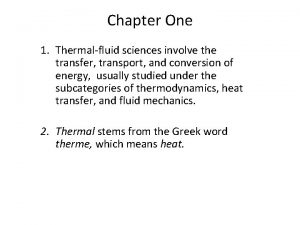Fundamentals of ThermalFluid Sciences 5 th Edition Yunus
























- Slides: 24

Fundamentals of Thermal-Fluid Sciences 5 th Edition Yunus A. Çengel, John M. Cimbala, Robert H. Turner Mc. Graw-Hill, 2017 Chapter 11 FLUID STATICS Lecture slides by Mehmet Kanoglu Copyright © Mc. Graw-Hill Education (Asia). Permission required for reproduction or display.

Objectives • Calculate the forces exerted by a fluid at rest on plane or curved submerged surfaces • Analyze the stability of floating and submerged bodies 2

11– 1 INTRODUCTION TO FLUID STATICS Fluid statics: Deals with problems associated with fluids at rest. The fluid can be either gaseous or liquid. Hydrostatics: When the fluid is a liquid. Aerostatics: When the fluid is a gas. In fluid statics, there is no relative motion between adjacent fluid layers, and thus there are no shear (tangential) stresses in the fluid trying to deform it. The only stress we deal with in fluid statics is the normal stress, which is the pressure, and the variation of pressure is due only to the weight of the fluid. The topic of fluid statics has significance only in gravity fields. The design of many engineering systems such as water dams and liquid storage tanks requires the determination of the forces acting on the surfaces using fluid statics. 3

11– 2 HYDROSTATIC FORCES ON SUBMERGED PLANE SURFACES A plate, such as a gate valve in a dam, the wall of a liquid storage tank, or the hull of a ship at rest, is subjected to fluid pressure distributed over its surface when exposed to a liquid. Hoover Dam. On a plane surface, the hydrostatic forces form a system of parallel forces, and we often need to determine the magnitude of the force and its point of application, which is called the center of pressure. When analyzing hydrostatic forces on submerged surfaces, the atmospheric pressure can be subtracted for simplicity when it acts on both sides of the structure. 4

Hydrostatic force on an inclined plane surface completely submerged in a liquid. The pressure at the centroid of a surface is equivalent to the average pressure on the surface. 5

The resultant force acting on a plane surface is equal to the product of the pressure at the centroid of the surface and the surface area, and its line of action passes through the center of pressure. second moment of area (area moment of inertia) about the x-axis. 6

The centroid and the centroidal moments of inertia for some common geometries. 7

Pressure acts normal to the surface, and the hydrostatic forces acting on a flat plate of any shape form a volume whose base is the plate area and whose length is the linearly varying pressure. This virtual pressure prism has an interesting physical interpretation: its volume is equal to the magnitude of the resultant hydrostatic force acting on the plate since FR = Pd. A, and the line of action of this force passes through the centroid of this homogeneous prism. The projection of the centroid on the plate is the pressure center. Therefore, with the concept of pressure prism, the problem of describing the resultant hydrostatic force on a plane surface reduces to finding the volume and the two coordinates of the centroid of this pressure prism. The hydrostatic forces acting on a plane surface form a pressure prism whose base (left face) is the surface and whose length is the pressure. 8

Special Case: Submerged Rectangular Plate Hydrostatic force acting on the top surface of a submerged tilted rectangular plate. 9

Hydrostatic force acting on the top surface of a submerged vertical rectangular plate. 10

Hydrostatic force acting on the top surface of a submerged horizontal rectangular plate. 11

11– 3 HYDROSTATIC FORCES ON SUBMERGED CURVED SURFACES Determination of the hydrostatic force acting on a submerged curved surface. 12

In many structures of practical application, the submerged surfaces are not flat, but curved as here at Glen Canyon Dam in Utah and Arizona. 13

When a curved surface is above the liquid, the weight of the liquid and the vertical component of the hydrostatic force act in the opposite directions. The hydrostatic force acting on a circular surface always passes through the center of the circle since the pressure forces are normal to the surface and they all pass 14 through the center.

in a multilayered fluid of different densities can be determined by considering different parts of surfaces in different fluids as different surfaces, finding the force on each part, and then adding them using vector addition. For a plane surface, it can be expressed as The hydrostatic force on a surface submerged in a multilayered fluid can be determined by considering parts of the surface in different fluids as different surfaces. 15

11– 4 BUOYANCY AND STABILITY Buoyant force: The upward force a fluid exerts on a body immersed in it. The buoyant force is caused by the increase of pressure with depth in a fluid. The buoyant force acting on the plate is equal to the weight of the liquid displaced by the plate. For a fluid with constant density, the buoyant force is independent of the distance of the body from the free surface. It is also independent of the density of the solid body. A flat plate of uniform thickness h submerged in a liquid parallel to the free surface. 16

The buoyant forces acting on a solid body submerged in a fluid and on a fluid body of the same shape at the same depth are identical. The buoyant force FB acts upward through the centroid C of the displaced volume and is equal in magnitude to the weight W of the displaced fluid, but is opposite in direction. For a solid of uniform density, its weight Ws also acts through the centroid, but its magnitude is not necessarily equal to that of the fluid it displaces. (Here Ws > W and thus Ws > FB; this solid body would sink. ) Archimedes’ principle: The buoyant force acting on a body immersed in a fluid is equal to the weight of the fluid displaced by the body, and it acts upward through the centroid of the displaced volume. 17

For floating bodies, the weight of the entire body must be equal to the buoyant force, which is the weight of the fluid whose volume is equal to the volume of the submerged portion of the floating body: A solid body dropped into a fluid will sink, float, or remain at rest at any point in the fluid, depending on its average density relative to the density of the fluid. 18

The altitude of a hot air balloon is controlled by the temperature difference between the air inside and outside the balloon, since warm air is less dense than cold air. When the balloon is neither rising nor falling, the upward buoyant force exactly balances the downward weight. 19

Stability of Immersed and Floating Bodies Stability is easily understood by analyzing a ball on the floor. For floating bodies such as ships, stability is an important consideration for safety. 20

A floating body possesses vertical stability, while an immersed neutrally buoyant body is neutrally stable since it does not return to its original position after a disturbance. An immersed neutrally buoyant body is (a) stable if the center of gravity G is directly below the center of buoyancy B of the body, (b) neutrally stable if G and B are coincident, and (c) unstable if G is directly above B. 21

When the center of gravity G of an immersed neutrally buoyant body is not vertically aligned with the center of buoyancy B of the body, it is not in an equilibrium state and would rotate to its stable state, even without any disturbance. A ball in a trough between two hills is stable for small disturbances, but unstable for large disturbances. 22

A floating body is stable if the body is bottom-heavy and thus the center of gravity G is below the centroid B of the body, or if the metacenter M is above point G. However, the body is unstable if point M is below point G. Metacentric height GM: The distance between the center of gravity G and the metacenter M—the intersection point of the lines of action of the buoyant force through the body before and after rotation. The length of the metacentric height GM above G is a measure of the stability: the larger it is, the more stable is the floating body. 23

Summary • Introduction to Fluid Statics • Hydrostatic Forces on Submerged Plane Surfaces • Hydrostatic Forces on Submerged Curved Surfaces • Buoyancy and Stability 24
 Human sciences tok definition
Human sciences tok definition Fundamentals of information systems 9th edition
Fundamentals of information systems 9th edition Sujata madan
Sujata madan Fundamentals of information systems 9th edition
Fundamentals of information systems 9th edition Fundamentals of corporate finance fifth edition
Fundamentals of corporate finance fifth edition Computer security fundamentals 4th edition
Computer security fundamentals 4th edition Machining fundamentals 10th edition
Machining fundamentals 10th edition Critical radius of insulation for cylinder
Critical radius of insulation for cylinder Digital fundamentals 10th edition
Digital fundamentals 10th edition Fundamentals of information systems 9th edition
Fundamentals of information systems 9th edition Fundamentals of corporate finance 6th edition
Fundamentals of corporate finance 6th edition Management fundamentals 8th edition
Management fundamentals 8th edition Fundamentals of organizational communication
Fundamentals of organizational communication The fundamentals of political science research 2nd edition
The fundamentals of political science research 2nd edition Digital fundamentals floyd ppt
Digital fundamentals floyd ppt Fluid mechanics fundamentals and applications 3rd edition
Fluid mechanics fundamentals and applications 3rd edition Abnormal psychology ronald j comer 9th edition
Abnormal psychology ronald j comer 9th edition Fundamentals of information systems
Fundamentals of information systems Fundamentals of organizational communication 9th edition
Fundamentals of organizational communication 9th edition Fundamentals of corporate finance canadian edition
Fundamentals of corporate finance canadian edition Electronics fundamentals a systems approach
Electronics fundamentals a systems approach Digital fundamentals floyd
Digital fundamentals floyd Yunus akkaya
Yunus akkaya Introduction about ramadan
Introduction about ramadan Yunus triyonggo
Yunus triyonggo



























